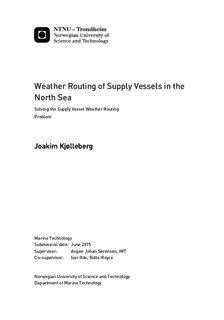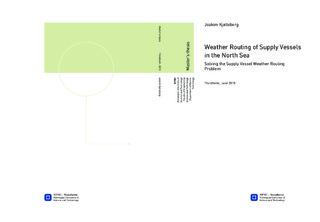| dc.description.abstract | This thesis is concerned with defining and solving the supply vessel weather routing problem. The particular problem in focus will be Statoil's supply circuit in the middle North Sea, including the Johan Sverdrup oil field. The thesis considers a single platform supply vessel doing a single trip to supply a given number of platforms. The goal is to find the cost optimal route. The approach will use standard weather forecasts and ship resistance models to calculate the cost for each candidate route.
The supplying of offshore installations are done with platform supply vessels. Today, these PSVs follow a weekly schedule in order to supply the installations and do not automatically account for severe weather. This can cause unwanted delays, extra vessel days, and in worst case installations shutting down production due to lack of supplies.
The main objective of this master thesis is to explore the topic of weather routing for supply vessels. The approach is to develop and document a 'proof-of-concept' MATLAB program, attempting to solve the supply vessel weather routing problem.
The core part of the program is the cost function, which can be tow energy, brake energy, fuel consumption, CO2-emissions or operational costs for the supply vessel. This function is subject to be minimised in order to find the cost optimal route. Some restrictions apply: Crane operations on rigs are subject to wave height limitations, typically 4 meters. Crane stops due to severe weather and nightly close-downs (of crane operations) introduce dynamic time windows. The only routing done is changing the order in which the installations are visited, and each unique sequence is a candidate route.
Every installation is to be visited once, each for a specified duration of time - a service time. The fleet size and mix vessel routing problem is assumed to be solved, so that a single vessel, single voyage needs to be optimised. It is assumed that the total demand does not exceed the vessel capacity, and that the supply allocation problem is solved. The speed between installations is governed by a reduced speed algorithm or a constant speed algorithm. The speed is reduced due to environmental loads, by keeping the propulsion power constant.
The results deem weather routing to be possible and feasible. For small waves (less than three meter significant wave height) the typical savings are <5%, which is not significant due to model- and forecast uncertainties. For borderline weather and complex time windows, savings has been observed in the 20%-range - by just changing the order of visiting installation.
The field of short sea weather routing is ripe for more research. Routing of wellboats and windmill service vessels, and life cycle simulations of supply vessels for future designs are other applications available through the presented program. | |

